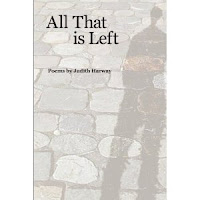The works themselves, as well as the reasons for their choosing (including "this is my favorite child", "I brought it due to its small size", and "it includes so many of my symbols" ) have varied in media, format, style and intent, but they have all sparked interesting and lively conversations as we get to know one another.
We'll be uploading photos of the works over the next few days. Here are a few ones to begin with:
Above is Clarice Zucker's watercolor "Purim".
Marc Tasman brought in "Antique store window on the way to the Kazimiers Jewish District in Krakow ," a photograph he took while exploring the Eastern European region of Galizia:

Judith Harway's book of poems "All That Is Left" was her elected one work. Click HERE to visit her website.
We are looking forward to seeing what those who have not yet "shown and told" will bring next time!
Also please remember that there are two assignments:
1. Read the material Jody passed out in class about the Matriarchs. Think about: How is Abraham Jewish? How are the Matriarchs Jewish? Is their Jewishness different from Abraham’s?
2. To be completed in the journal: Your Personal Wandermap. Copy a definition of WANDERING and record where it’s from. Then write YOUR OWN definition of wandering. Finally, make your WANDERMAP (or wondermap!). Maps can be visual, written, or a combination or both and can include any kind of media. They should mark no less than five different “places.” These are stops you have made along the way, and can be real or imagined or geographical or spiritual or symbolic. It is all about YOU as a person and artist!
Last but not least: A big thank you to Barbara Kohl-Spiro for bringing in original early 20th century works, from her private collection, made at the (then) “Bezalel School of Arts and Crafts”(Now the “Bezalel academy of arts and design Jerusalem” website HERE). What a treat to see and touch those beauties!


This comment has been removed by the author.
ReplyDeletesaid...
ReplyDeleteIn case some people are still wondering how to say wandering in Spanish... It seems that there are words that translate it (vagar, vagabundear) but their meaning is not exactly the same as in English.
Here's a good explanation:
http://www.wordmagicsoft.com/diccionario/en-es/wandering.php
Jody- What is the Hebrew word for wandering?
an easy approach is pick out wandering in hebrew bible with verse and line, then go to spanish bible and find the translation used. could try several such verses/lines or different spanish translations to see if one word used regularly.
ReplyDeleteSHORT REVIEW OF SHIRAH SHOW
ReplyDeleteok i got there this morning, they unlocked the room for me (patrick) but it seems that one piece was down but i did see the tsitIS (sp?) and really enjoyed it. wished it could have been out of that corner and more subject to self-generated currents in walking around it. very nice. nicely proportioned too, height to base and nicely draped. the cloth pieces pierced by chord well treated also, and composition excellent with many tiers from top to bottom all by definition literally hung together and showing all the natural stress lines and lines of force inherent in a top hung object (i of course do bottom to top and always supported from below not above so opposite of how i think of a structure). any way, all the lines vertical horizontal and in between very well composed. i also liked that the treatment wasn't overly finished, i like process so i like seeing the stitches and the welds, the frayed edges and discolorations and varying color grades of the whites.
by the way (i know that no one cares except me) did you know that when you hang a chord between two fixed points (or a chain or anything) the curve described is NOT a section of a parabola or an ellipse which many people assume because gravity of satellites or moons or planets are defined usually by those theoretical curves under the influence of gravity. but with chords or fabrics it is a more complex curve described because the line it is deflected also by the weight of the chord itself, whereas the line described by a planet or moon or artillery shell or thrown rock is parabolic but THOSE imaginary lines don't have weight themselves like the weight of a chord or in two dimensions a fabric. don't know why i'm saying this but i always thought that this was a little known but interesting fact...at least for me. so that the "sag" of an actual flexible object like yours is different than imaginary theoretical lines of newton's gravity. and therefore, in my opinion, more natural. so that when i want natural looking curves from metal (again i build up from the bottom) i am careful to stay with lines more like those you have created...that are NOT parabolic or eliptical but more self-seeking under their own weight. for me this piece has a lot to do with weight and with its absence.
wish i could see more.
i won't be at kohler or there on dec. 19th, so happy new year!
one other idea on spanish for wandering: here is quote from Don Quixote in english translation win which the word wandering occurs. now if you can find the spanish...? also in english he is referred to as the Wandering Knight so in Spanish how...?
ReplyDeletethe curate and the barber listened with great amusement to the words of the three ; but Don Quixote, ... We sallied forth together, we took the road together, we wandered abroad together ; we have had the same fortune and the same ...
ok natanya this is REALLY my final comment. the above quote from Don Quixote, i neglected to say, is from chapter two (where sancho panza goes forth to quixote niece) about the twelfth paragraph. so if you have spanish edition maybe you can find that translation of wandering.
ReplyDelete